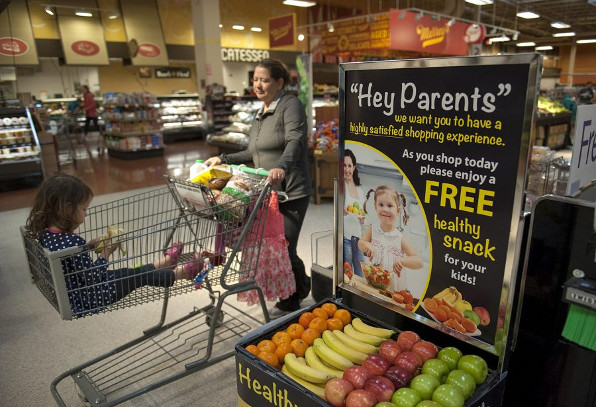It seems pretty obvious, but there are twists in the conclusions of the latest survey of kids’ eating habits that make one wonder how kids really think, why they make the decisions they do about the foods they prefer, and how malleable they remain through childhood, the tween years and their teens…
 A welcome trend: Many supermarkets offer free fruit for kids in their produce departments.
A welcome trend: Many supermarkets offer free fruit for kids in their produce departments.
Not only do parents have a more comfortable shopping experience, without the kids
screaming for treats, but they also get to see what healthy foods their kids prefer.
A study just released by researchers at the Tufts University Health Sciences Campus shows that all it takes to get kids to eat more healthfully is to offer them free Fruits and Veggies, starting around the time they start school.
Study findings indicate tat childhood is a key time to develop attitudes toward food and nutrition and potentially life-long eating habits. School food policies seek to provide and/or encourage healthy food choices during the school day, from offering students free fruits and vegetables outside of standard school meals to outlining limitations on the availability, portion sizes, or sales of sugary drinks.
By the numbers…
The researchers estimated that a provision for free fruits and vegetables would lead to an increase in habitual fruit consumption across school-age children over a period of one-two years, as follows:
- 17 percent increase for children in elementary school;
- 22 percent in middle school; and
- 25 percent in high school.
Sugary drinks
A limitation on sugary drinks would decrease habitual consumption and have a modest effect on BMI across school-age children, specifically:
- 27 percent decrease in consumption and .7 percent decrease in BMI for children in elementary school;
- 19 percent and .5 percent in middle school; and
- 15 percent and .5 percent in high school.
In analyses including the potential effects of a national fruits and vegetables provision on BMI, the researchers estimated an additional 0.1 percent reduction.
My take…
It just makes sense that, by offering healthy foods for free, and not limiting access to those foods in any way, that kids would gravitate towards them and away from unhealthy foods and sugary beverages which were still offered, but at a price (financial disincentive) and under restricted availability. When I was little, I always tried what was available free before resorting to spending even a few cents on something else. (I say a few cents; when I was little, Candy Bars were $0.10, Pop was $0.15 a bottle and Penny Candy was still available for just a penny. And McDonald’s had not yet come to Eastern Canada.)
What amazes me – in a good way – is that the kids in the study seem to have taken their healthy eating habits with them into their teen years, and, presumably, on into adulthood. If simply offering healthy foods for free and disincentivizing unhealthy ones can influence kids’ own, independent food choices and the effect persists, I thi9nk it’s something all school boards and governments should be looking. Not to mention the prime examples kids follow in their lives: Their parents!
~ Maggie J.

